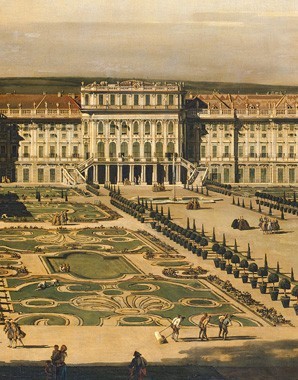A family presents itself - Maria Theresa and the image of the dynasty
Under Maria Theresa, the Habsburg dynasty underwent something that would be referred to in current media-speak as a ‘relaunch’. The manner in which Maria Theresa presented herself to the public, as well as her presentation of the Habsburg-Lothringen dynasty - newly founded not just in genealogical terms - would surely be the envy of modern PR agencies.
From: Arneth, Alfred: ‘Zwei Denkschriften Maria Theresas’, in: Archiv für österreichische Geschichte, 47 (1871), p. 287. Quoted from Marius Pasetti/Susanne Strass: ‘Hofetikette und Hofzeremoniell im Absolutismus unter besonderer Berücksichtigung des Wiener Hofes’, in: Schloss Schönbrunn – Lernbehelf für Guides, vol. 2, 3rd edition, Vienna 1994, p. 114.And as much as I love my family and children too, so much that I will spare no industry, care, anxiety, or effort for their sake, yet the universal best for my countries has always priority over my family since, of these countries, I am the universal and prime mother.
Maria Theresa transformed her exceptional position as a woman on the Habsburg throne through deliberately emphasizing, to her advantage, her ‘female virtues’, as these were understood under the patriarchal social order of the day. She stage-managed herself as a wife and proud mother of sixteen children, wholesome and devoted, down-to-earth and endowed with a sense of reality. The harmony in her marriage and her family, as communicated to the outside world, was intended to serve as a positive counter-image to dynastic aloofness and courtly froideur. The Enlightenment notion of family life was propagated, and this had all-the-more positive repercussions in the nineteenth and twentieth centuries, when the bourgeois ideal of the family became a guiding example.
Most of all, the aspect of motherliness was stressed, whether in Maria Theresa’s own family or, in the figurative sense, presenting her as the national mother of her subjects. Here, it should be remembered that, in the background, there existed the risk of the dynasty coming to an end following the death of Maria Theresa’s father. An immense number of portraits of her children at various ages were commissioned; family pictures were intended to underline the dynasty’s vitality.
The large-scale representations of memorable events during Maria Theresa’s reign, created during her own lifetime, are famous. These include the securing of her inheritance in the War of the Austrian Succession, and the foundation of the Order of St Stephen in 1764 as a sign of affinity with Hungary which, under Maria Theresa, had changed from being an eternal battlefield and crisis region and become one of the core territories of Habsburg power.
Asserting the uninterrupted continuity of the Habsburg dynasty, notwithstanding its ‘relaunch’ after 1740, was also an important aspect. The claim to the imperial title was well documented in ideological terms (in a series of images of the coronation of Joseph II in Frankfurt in 1764), while from a biological perspective, the dynasty continued through the marriage of Joseph II to Isabella of Parma in 1760.
The latter years of Maria Theresa’s life were marked by the staging of a veritable cult around the memory of her husband, Emperor Franz Stephan, who died in 1765. The famous Vieux-Laque Room in Schönbrunn Palace is an example of this. The portrait of Franz Stephan in the middle of this memorial room is flanked by the double portrait of his eldest sons and successors Joseph II and Leopold II, as well as a representation of his daughter-in-law Maria Ludovica, accompanied by her children, as a symbol of the dynasty’s continuation through the future generations of the family.



























